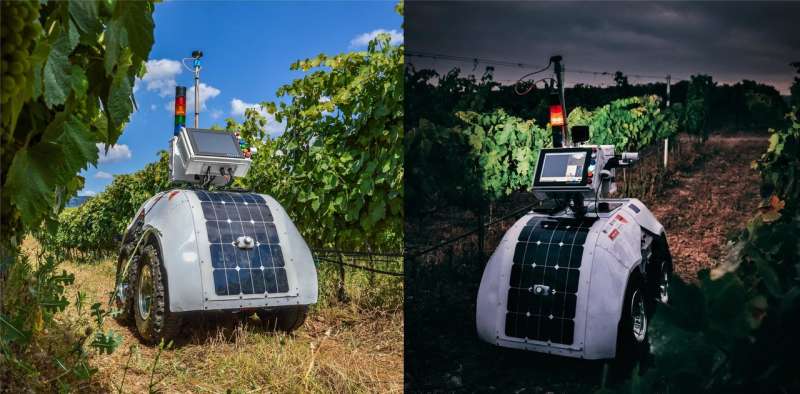VineScout day and night. Credit: Asociación RUVID
Grapes must be picked at the exact point of maturation, and its plant must have the appropriate intake of water during development so that the wine ends up with desired properties. Controlling those parameters is complicated and expensive, and few can afford to use pressure chambers that measure water potential.
"This prevents the vine-grower and winemaker from having access to complete and reliable information during the grape's growth and maturation cycles on a regular basis and in real time. Thus, a majority of producers don't use data that could help them optimise the handling of their vineyard and, ultimately, influence the quality of the wine they produce," explains Francisco Rovira, head of the Laboratory of Agricultural Robotics (ARL) of Valencia's Polytechnic University (UPV).
To solve this deficiency, a European research consortium headed by the UPV is working on an automated robot for vineyard monitoring in the framework of the VINESCOUT project. The end goal is to help wine producers measure key parameters of their vineyards, including water availability, the temperature of the leaves and plant robustness.
After almost two years of work, they showed off the newest prototype in Portugal in late August. "Our robot enables intensive sampling, going from the 20 measurements per hour that the traditional method allows, to more than 3,000 pieces of data per hour without the user having to make an effort to get these measurements. At the end, the producer obtains a map of his plot of land with data that gives them an idea of when to activate the watering systems if they have one installed, or of the harvest date, as well as the most productive plant distribution for their vineyard," says professor Francisco Rovira, coordinator of the European project.
As well as the UPV, the Televitis research group from the Universidad de La Rioja (televitis.unirioja.es/) is taking part, as well as French company Wall-Ye SARL, the British Sundance Multiprocessor Technology Ltd and the Portuguese Symington Family Estates.
Among the novelties of the new prototype are an improvement in autonomous navigation, which makes the system more robust by combining 3-D with LiDAR and ultrasound sensors (sonar). The built-in artificial intelligence has also been improved, resulting in more accurate handling when guiding it through the vineyard and turning to change row.
"The autonomous navigation system has improved a lot, which means the vehicle can move faster and more safely through the vineyard rows, while maintaining the same data collection ability," says Verónica Saiz, researcher of the Laboratory of Agricultural Robotics of the UPB and project manager of this project.
The robot can also generate maps at night, thus broadening its work capacity. This option, automated nighttime navigation, was tested this summer during field tests in the Portuguese vineyard. "We have verified that the robot operates the same at night and during the day, and is able to generate automated maps of the thermal status," says Saiz. Furthermore, the robot also includes a multispectral camera to measure robustness through various vegetative indicators.
More compact, agile and with more energy
The external appearance has also been modified compared to the previous prototype. "Now, the robot is more compact and agile, and has more protection from a hostile environment such as these fields. Furthermore, it has lithium batteries instead of lead, like the previous model, which are lighter and therefore more easily interchangeable, and guarantee enough energy for an entire working day," explains Andrés Cuenca, fellow researcher at the UPV's ARL.
"We already have the first automated temperature and plant robustness maps; they are generated by the robot in real time with an infrared sensor and a multispectral camera. The next step is to check whether these maps have good correlations with those obtained with manual methods; if this is so, we will have a much more effective and practical automated monitoring system for vine-producers and winemakers," adds Francisco Rovira.
Provided by Asociacion RUVID






















